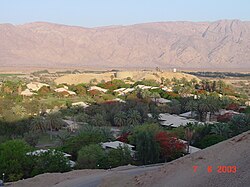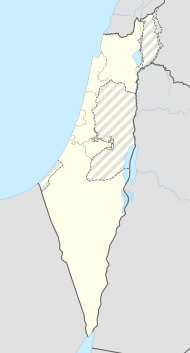Jotvata
| Jotvata | ||
|---|---|---|

|
||
| Basic data | ||
| hebrew : | יטבתה | |
| State : |
|
|
| District : | south | |
| Founded : | 1951 | |
| Coordinates : | 29 ° 54 ' N , 35 ° 4' E | |
| Height : | 81 m | |
| Residents : | 696 (as of 2018) | |
| Community code : | 0866 | |
| Time zone : | UTC + 2 | |
| Website : | ||
|
|
||
Jotvata (also Yotvata , Hebrew יטבתה) is a kibbutz in the Israeli Arava Depression . It is located in the southern Negev near the Jordanian border, about 40 kilometers north of Eilat and had 696 inhabitants in 2018.
Modern place
Jotvata was founded in 1951 as a military settlement, later today's kibbutz emerged from it. The settlement is located at a strong spring of the same name, which is already mentioned in the Bible ("a land with streams of water", Dtn 10.7 EU ).
The most important branches of the economy on the kibbutz are the dairy industry with a milk processing plant and tourism . The Chai Bar Jotvata animal park has been set up near Jotvata . This zoo provides a habitat for animals that were native to this area in biblical times and forms the basis for their resettlement in Israel (see also animals in the Bible ).
archeology
The good water supply of the place made a settlement possible at least since the Iron Age . From 2003 to 2007 excavations took place under the direction of Gwyn Davies ( Florida International University ) and Jodi Magness ( University of North Carolina at Chapel Hill ).
Remains of a two-story building made entirely of stone have been discovered near the springs. The accompanying pottery covers the period from the 2nd century BC. Until the 2nd century AD. It consists of Hellenistic , Nabataean and early Roman sherds. The building was destroyed by an earthquake at the beginning of the 2nd century.
About 500 meters away, a Nabatean building of 30 × 35 meters has been proven, which possibly corresponds to the temple Ad Dianem , which is recorded on the Tabula Peutingeriana .
A late Roman fort was excavated a kilometer southwest of the kibbutz at the foot of the Negev hills . It measures about 40 meters square on the outside and had a watchtower on every corner. An inscription attests to the building around the year 300. It was equipped with a bathroom that is very large for the garrison alone. It may also have been available to travelers. After the first destruction by fire, the fort had three more construction phases. It was abandoned around 370-380.
In the 5th century the Byzantines used the castle again for a while. Most recently there was an early Islamic settlement phase in the late 6th or early 7th century.
The architectural remains were crossed and badly damaged by the construction of an oil pipeline in 1958.
literature
- Erhard Gorys , Andrea Gorys : Holy Land . (DuMont art travel guide) DuMont, Ostfildern 2006, ISBN 3-7701-6608-6 , p. 370.
- Uzi Avner, Gwyn Davies, Jodi Magness: Yotvata - 2003 . In: Hadashot Arkheologiyot - Excavations and Surveys in Israel , 117, 2005
- Gwyn Davies, Jodi Magness: Yotvata - 2004 . In: Hadashot Arkheologiyot - Excavations and Surveys in Israel , 117, 2005
- Gwyn Davies, Jodi Magness: Yotvata - 2005 . In: Hadashot Arkheologiyot - Excavations and Surveys in Israel , 118, 2006
- Gwyn Davies, Jodi Magness: Yotvata - 2006 . In: Hadashot Arkheologiyot - Excavations and Surveys in Israel , 119, 2007
- Gwyn Davies, Jodi Magness: Yotvata - 2007 . In: Hadashot Arkheologiyot - Excavations and Surveys in Israel , 120, 2008
- Tali Erickson-Gini: 'En Yotvata. Final report. In: Hadashot Arkheologiyot - Excavations and Surveys in Israel , 124, 2012
Web links
Individual evidence
- ↑ אוכלוסייה ביישובים 2018 (population of the settlements 2018). (XLSX; 0.13 MB) Israel Central Bureau of Statistics , August 25, 2019, accessed May 11, 2020 .
- ↑ אוכלוסייה ביישובים 2018 (population of the settlements 2018). (XLSX; 0.13 MB) Israel Central Bureau of Statistics , August 25, 2019, accessed May 11, 2020 .
- ↑ Tali Erickson-Gini: 'En Yotvata. Final report. In: Hadashot Arkheologiyot - Excavations and Surveys in Israel , 124, 2012
- ↑ Uzi Avner, Gwyn Davies, Jodi Magness: Yotvata - 2003. In: Hadashot Arkheologiyot - Excavations and Surveys in Israel , 117, 2005
